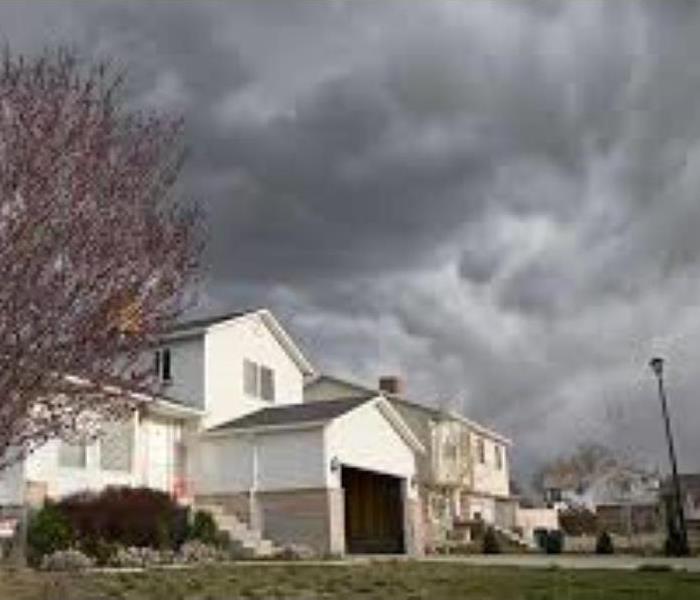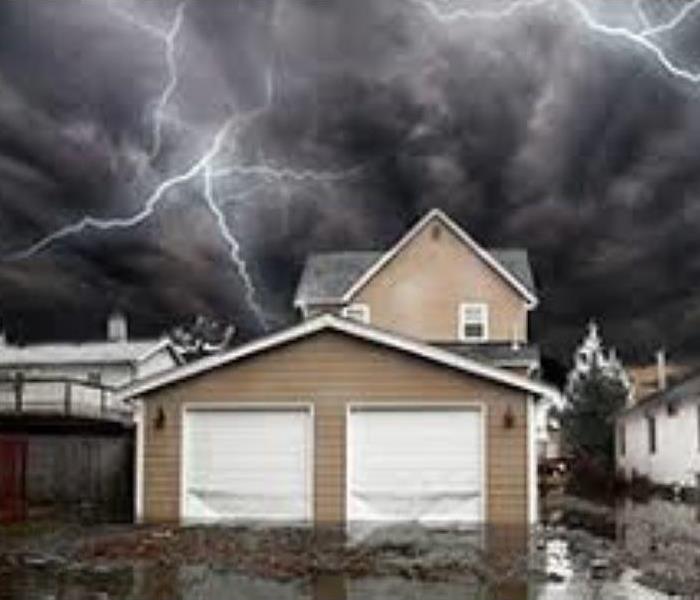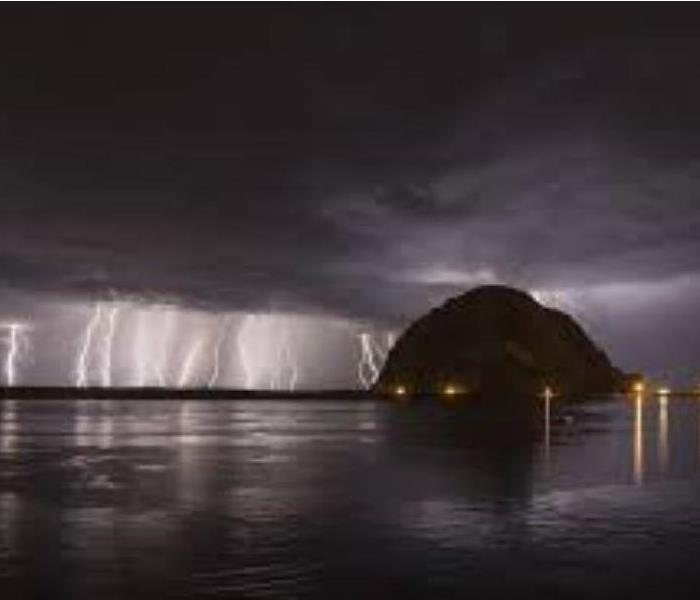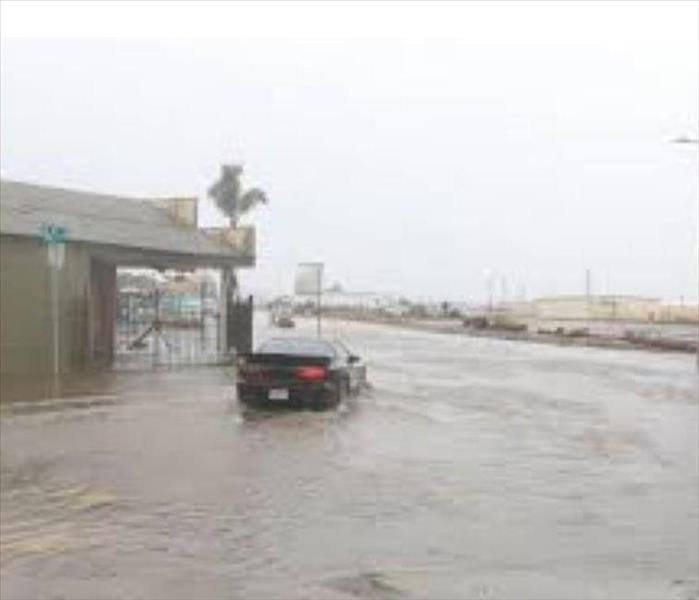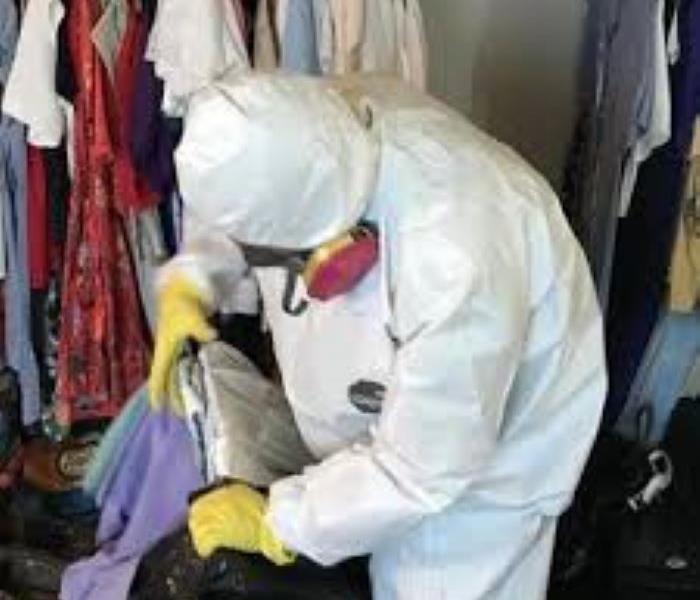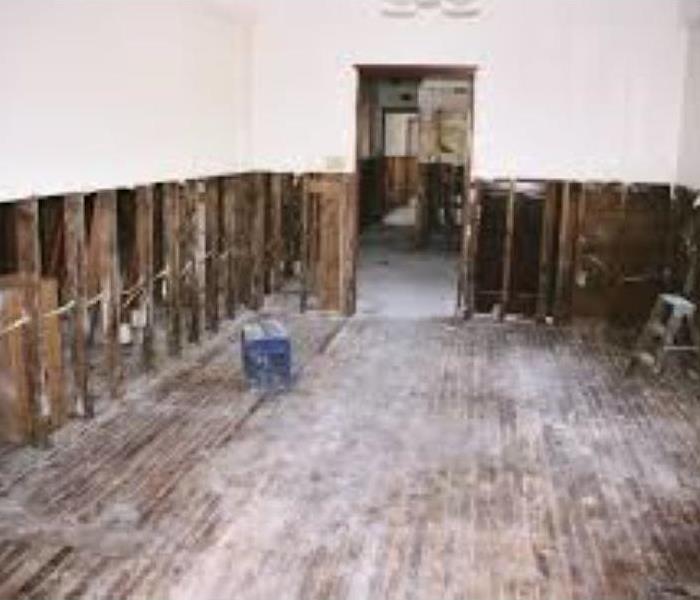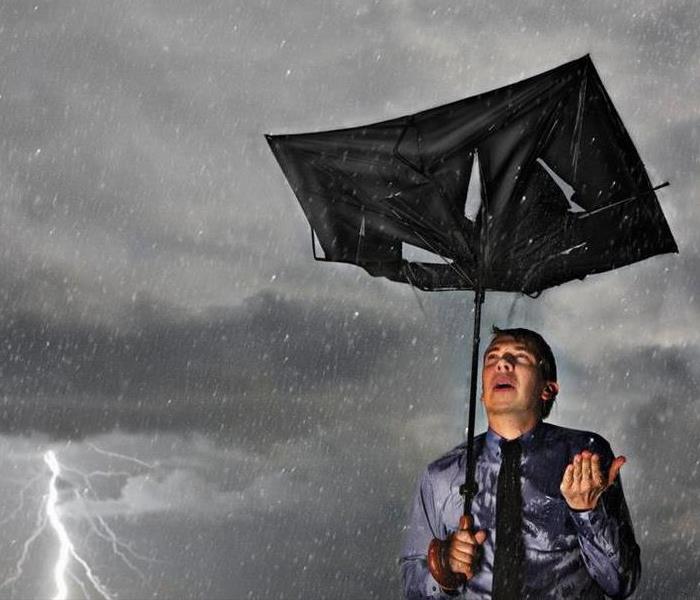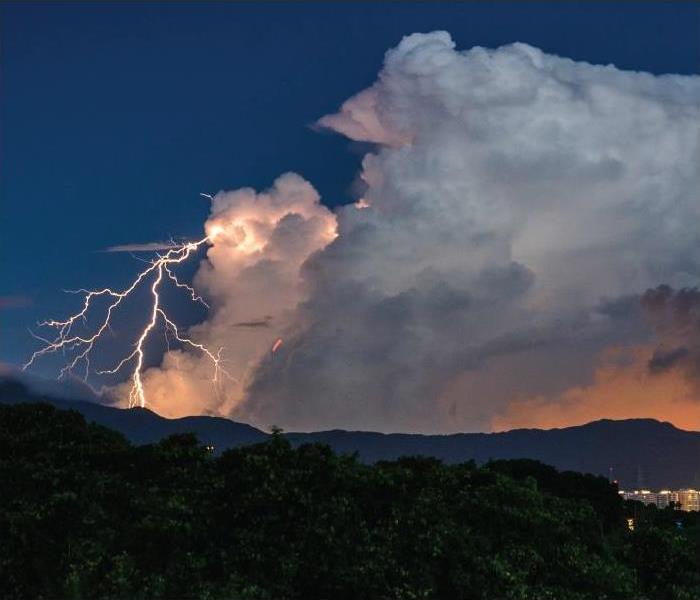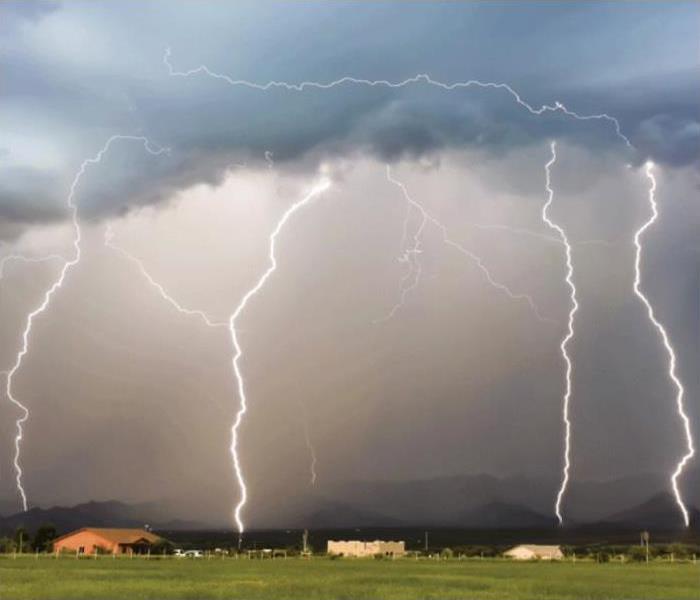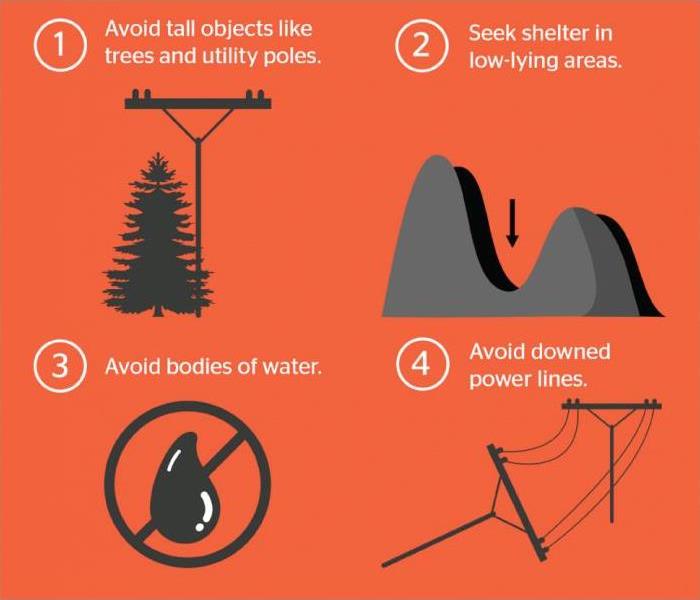Recent Storm Damage Posts
Why are clean gutters necessary?
9/19/2023 (Permalink)
A clogged gutter is a disaster waiting to happen, especially during storm season. When gutters are blocked, water can’t flow away from your home, leading to potential flooding and water damage. It’s a simple task, but one that many homeowners overlook.
Regularly cleaning your gutters ensures that water can flow freely, reducing the risk of flood damage. The experts suggest making gutter cleaning a part of your regular home maintenance routine. It’s a small task with big benefits, so don’t underestimate its importance. A clean gutter is a functional gutter, and a functional gutter is a flood-free home.
Have a question or need some advice on how to safeguard your house?
Call us! 805-674-5771
Remember, being properly prepared will prevent damage to your home, property or business.
Do You a Flood Safety Measure in Place?
9/19/2023 (Permalink)
Always have an emergency plan and flood safety measures in place. This includes knowing where to go in case of an evacuation, having an emergency kit ready, and installing flood barriers if you live in a flood-prone area. These measures may not directly impact your roof, but they are crucial for overall home safety during a storm.
It’s best to have a comprehensive emergency plan that all family members are familiar with. This should include contact numbers, evacuation routes, and the location of your emergency kit. Flood safety is not just about avoiding water damage; it’s about ensuring the safety and well-being of your family.
Remember, being properly prepared will prevent damage to your home, property or business.
Call us for advice!
805-674-5771
Dealing with Winter Storm Damage
12/29/2021 (Permalink)
Know the Risk of Winter Weather
The frigid temperatures and Central Coast winds can also cause frozen pipes. Once these pipes thaw can cause major flooding. These types of breaks typically cause major damage to the home and personal belongings.
Other than flooding, water damage may not be as easy to detect because it can sometimes take several days or even weeks to notice, and it doesn’t always appear in ways you’d think it would. Discoloration, cracks, drywall tape loosening and water spots can take days to show up on ceilings.
Despite all of its icy coldness, winter can also bring increased risk of fire. During these cold spell we tend to utilize other heating sources to maintain our homes. These space heaters increase the risk potential of fire.
How to Respond to Winter Storm Damage
- Contact your insurance company- Let them know about the damages to your home. Review your coverages, policy limits on the policy and your deductible.
- Take photos of the damages
- If water is intruding in your home, take immediate action and call SERVPRO, we are here to help.
Regardless of the damages to your home, the most important steps is keeping yourself and family safe. It can be emotionally and physically exhausting for homeowners to deal with storm damages. Take time to care for yourself while your home is being mitigated and repaired. Ask questions often to fully understand the process. This includes questions to the claims adjuster, restoration contractor, and other parties involved in the claim. Take notes to help process all the information you are receiving. Save all your receipts of out of pocket expenses to discuss with your claims adjuster.
We are here to help, "Like it never even happened."
How To Handle Storm Damage in Paso Robles
12/28/2021 (Permalink)
When storm damage hits Central Coast homes and businesses, it's important to know what to do until SERVPRO crews get on site.
- Call SERVPRO at (805) 674-5771 immediately upon discovering damage.
- Shut off the source of water (ie: replace sump pump) or contact a qualified party to stop the water source.
- Remove as much excess water as possible by mopping and blotting. Use a shop vac or carpet cleaning machine to suck water from carpets. Do Not use a household vacuum cleaner.
- Place aluminum foil or wood blocks between furniture legs and wet carpeting.
- Remove electronics, documents, sensitive or valuable items to a dry place.
- Use wooden clothespins to keep furniture skirting and window curtains off damp floors.
- Pull carpet back from the walls to limit water wicking into the drywall.
Don't forget that when storm damage strikes on the Central Coast, SERVPRO is here to help!
Does Your San Luis Obispo Home Have A Mold Problem?
12/27/2021 (Permalink)
Microscopic mold spores naturally occur almost everywhere, both outdoors and indoors. This makes it impossible to remove all mold from a home or business. Mold remediation reduces the mold spore count back to its natural or baseline level. Some restoration businesses advertise “mold removal” and even guarantee to remove all mold, which is not accurate.
- Mold is present almost everywhere, indoors and outdoors.
- Mold spores are microscopic and float along in the air and may enter your home through windows, doors, or AC/heating systems or even hitch a ride indoors on your clothing or a pet.
- Mold spores thrive on moisture. Mold spores can quickly grow into colonies when exposed to water. These colonies may produce allergens and irritants.
- Before mold remediation can begin, any sources of water or moisture must be addressed. Otherwise, the mold may return.
- Mold often produces a strong, musty odor and can lead you to possible mold problem areas.
- Even higher-than-normal indoor humidity can support mold growth. Keep indoor humidity below 45 percent.
If your home or business has a mold problem, we can inspect and assess your property and use our specialized training, equipment, and expertise to remediate your mold infestation.
Call SERVPRO Today – 805-674-5771
When Storms or Floods hit the Central Coast, SERVPRO is ready!
12/22/2021 (Permalink)
SERVPRO of Morro Bay / King City specializes in storm and flood damage restoration. Our crews are highly trained and we use specialized equipment to restore your property to its pre-storm condition. Faster Response Since we are locally owned and operated, we are able to respond quicker with the right resources, which is extremely important. A fast response lessens the damage, limits further damage, and reduces the restoration cost. Resources to Handle Floods and Storms When storms hit the Central Coast, we can scale our resources to handle a large storm or flooding disaster. We can access equipment and personnel from a network of 1,650 Franchises across the country and elite Disaster Recovery Teams that are strategically located throughout the United States. Have Storm or Flood Damage? Call Us Today 805-674-5771
How to Prepare for Severe Weather
11/30/2020 (Permalink)
Nine Storm Preparation Tips
- Get and stay informed.
Tune in to the local radio or TV station and community alert system for emergency information. Keep a battery-operated/solar-powered radio on hand.
- Inspect the emergency survival kits and the food and water supply.
The emergency kits should be stocked with essential items. If one or more are not available, purchase the necessary items to properly outfit the kits. Stock up with a two-week supply of food and water.
- Round up plenty of LED flashlights and batteries.
LED flashlights burn much brighter and last much longer than traditional flashlights. Heavy-duty solar-powered landscape lights can perform a double function as an attractive landscape feature and as an emergency light. Gather them up before the threatening storms, tornadoes, or approaching hurricane.
- Fully charge the car chargers.
The chargers can be used to charge a personal cell phone, smartphone, and other portable devices.
- Secure all outdoor furniture.
Secure outdoor furniture and other objects or move them inside. An EF-2 (135 mph) or EH-3 (140 mph) tornado can destroy an outdoor swing or trampoline. Deck furniture can disappear never to be seen again.
- Collect tools and emergency building materials.
Sandbags, plywood, and waterproof tarps will come in handy if windows are blown out, or a roof is torn off, or the shingles are damaged. Keeping as much water as possible out of homes and businesses will reduce damage to the interior. Keeping the inside as dry as possible will hinder the growth and spread of mold.
- Fill up automobiles and equipment.
Store fresh fuel for the emergency generator if one is available. Use approved fuel containers and store the fuel in a safe, dry place.
- Know how to shut off the utilities.
Should the home or business receive extensive damage, it may be necessary to shut off utilities, such as gas, electricity, and water. If evacuation is required, turn off utilities before leaving if time permits.
- Gather documents and records.
After a severe storm disaster, residents may need ID to prove who they are. Gather and store ID documents in a portable waterproof, fire-safe security chest. Important identification documents include birth certificates, Social Security cards, marriage certificates, adoption papers, passports, naturalization documents, wills, living wills, powers of attorney, and property deeds/titles. If there is room in the chest, include essential or memorable DVDs, portable disks, and flash drives. A better solution may be to create a document cache with files and images of relevant documents, ID cards, and photos. This cache can be stored on the cloud, and duplicated on a flash drive that is kept on hand. Personal IT management is essential, especially during and after a house fire or natural disaster.
Conclusion
Preparation is the key to weathering the storm when it hits. When it does, contact a storm damage restoration specialist. Emergency tarping and boarding, site stabilization and security, immediate water damage restoration, and other disaster recovery procedures can best be implemented by expert technicians facilitated by advanced equipment and technologies.
SERVPRO of Morro Bay to King City is a trusted leader in the restoration industry as well as in the local community. We provide 24-hour emergency service and are dedicated to responding faster to any size disaster. We pride ourselves on having not only the training but also the expertise to handle our customer's restoration and cleaning needs. We are locally owned and operated and can respond immediately to any emergency. Being locally owned, we make every effort to stay involved in the community providing our time and services when needed.
After a Storm
11/25/2020 (Permalink)
What should you do after a storm floods your home? After a significant weather event, you may find yourself dealing with conflicting impulses. On one hand, you'll be eager to start the cleanup process right away. On the other hand, you'll probably feel overwhelmed and unsure where to start. While it’s best to have a restoration professional working through the process on your behalf, there are certain steps you can begin while you wait for help to arrive.
Safety First
The first and most important thing to know is how to re-enter a building safely. Never begin damage mitigation until a building has been cleared as safe.
- Do not touch electrical equipment if you are wet yourself or standing in water.
- Don’t walk through floodwaters. Water can be contaminated by oil, gasoline, or raw sewage or possibly even be electrically charged. (See our earlier blog post on water contamination levels.)
- Turn off electricity to any rooms that are affected by flooding.
- Don’t operate any electrical equipment while standing in wet or damp locations.
- Do not turn on ceiling fixtures if ceiling is wet or enter rooms where ceilings are sagging from retained water.
- Wear protective clothing such as boots, long pants, and gloves when entering your home or dealing with flooded areas. I realize this is going to be uncomfortable in Austin since storm season is generally in the late summer heat, but it’s not worth the risk of injury to wear shorts in a flood clean-up.
Next Steps
Once you get into your building, notify your insurance agent. Your policy guidelines will influence your next steps and your agent should be able to recommend a trusted water restoration team in your area. To make sure that your agent has an accurate assessment of the damage, take photos or video to record the condition of your building and possessions. Don’t move any objects or collections without documenting their condition.
At SERVPRO of Morro Bay to King City, we’re ready to answer your call 24 hours a day, 7 days a week, but there are still some steps you can take the moment you get back home while you’re waiting for our team to arrive.
The faster you act, the more effective the restoration process will be and the better your chances are of saving water damaged possessions.
- Remove any paintings, art objects, documents and other sensitive materials to a safe, dry place.
- Wipe excess water from wood furniture after removing lamps and tabletop items.
- Raise wooden furniture out of standing waters and place on blocks if possible.
- Remove as much excess water as possible by mopping and blotting.
- Move large furniture away from walls for better air circulation.
- Remove and prop up wet upholstery cushions for even drying.
Tips for Carpet Care
If the affected room is carpeted, there are a few things you can do to prevent further damage to your carpet that might not be obvious if you’ve never been through a flood before.
- Place aluminum foil between furniture legs and wet carpeting.
- Remove books, newspapers, magazines, or other colored items from wet carpets.
- Do not leave colored area rugs on wet carpets (or white rugs on wet colored carpets). Color transfer from one can stain the other.
Let Us Help You
Most people only ever have to recover from a flooded home once in their lifetime. When it does happen, it’s good to have a partner who has been through this before. At SERVPRO of Morro Bay to King City, we have years of experience and the backing of the SERVPRO system to draw on and help make your home "Like it never even happened."
If you are dealing with flood damage, call us for help at (805) 674-5771 or request help online today.
Morro Bay Property Under Water? Rely on SERVPRO for Full Service from Pack Out to Rebuild
10/28/2020 (Permalink)
Pack Out Helps Minimize Flood Damage in Morro Bay Home
When flood damage happens to your home, it is vital to get cleanup efforts going as quickly as possible. The less exposure to water your home and contents have, the better the chances of saving more items through restoration efforts.
Our local SERVPRO responded to a call to mitigate flood damage in an Morro Bay home. Several areas in the house were affected, and the electricity was turned off. For safety reasons, we confirmed the homeowner and her family were staying off-site at another location.
Since this type of water intrusion carries a rating as the most contaminated, category three or "black water" event, we have protective gear we wear to work with this type of water loss. Upon arrival, our technicians found most of the water had since receded, but the water line on a wall indicated water levels were over the outlets at one point.
With the permission of the insurance adjuster and homeowner, a team of technicians carefully packed and moved out room contents that had the potential for restoration (we call it "pack out") and placed the items that were a loss in a separate bin. Our SERVPRO crew chiefs make detailed notes for items that are packed out and objects that are a loss for full transparency with the adjuster and homeowner.
We have powerful generators so the lack of electricity does not slow down remediation efforts. Using our portable pumps, we extracted as much water as possible, so large scale items such as the carpet and padding are easier to handle when we removed them as a loss. Carpets covered with Black Water we always recommend to discard. This also lessens the drying time and can save more building materials and contents.
Measuring roughly six inches above the water line on the walls, our technicians removed the ruined sheetrock with a technique called flood cutting, so the interior of the wall could dry thoroughly. We spend extra time on the extraction of water and setting up drying using applied structural drying techniques to limit water damage and inhibit additional issues such as mold or foul odors. This process can take several days, depending on the extent of the flooding. After drying, we cleaned and disinfected the property and left it ready for rebuilding.
Our crew chief gave the homeowner and adjuster a list of the necessary repairs needed to return the residence to its preloss condition. Since we are a full-service cleanup and restoration company, we can provide a "one-stop shopping" experience for our customers and complete the rebuilding and renovation of the house, with less stress of involving numerous contractors, and for less money. "Like it never even happened."
When you need fast assistance with flood damage, call SERVPRO of Morro Bay to King City at 805-674-5771. Our certified technicians are available 24-hours to help restore your home and contents from water loss.
It's Raining, It's Pouring, and It's Causing Storm Damage to Morro Bay Houses
10/28/2020 (Permalink)
Fast Morro Bay Home Flood Damage Cleanup by SERVPRO
Flood damage is bad enough when it happens, it is even worse when your home receives water damage, and you are not home to stop it. The longer building materials have exposure to excessive moisture lessens the chance of restoration.
When a homeowner came home from a weekend getaway, she walked into a drenched room from a tree branch breaking a window during heavy thunderstorms that rolled through and rain entered the Morro Bay home for hours.
After contacting her insurance adjuster, her next phone call was to our local SERVPRO facility. Our technicians arrived within hours of the initial call and immediately tarped over the broken window so additional damage from rainstorms would not affect the interior of the property any further.
We scoped the room to determine all the areas that the water could have possibly migrated into to ensure we did not miss any areas of excessive moisture. Our certified Water Damage Restoration Technicians worked on extraction the remaining water from the property. Because it sat for a minimum of 48 hours before mitigation efforts began, we handled the water as a category three (black) or contaminated water situation requiring specialized safety gear and disinfectants.
Some sheetrock around the entry point had become oversaturated and required removal, which we accomplished with a controlled demolition technique known as "flood cuts." This method lets adequate airflow happen within the wall cavity and substructure.
We then set up our drying and dehumidification equipment and ran air scrubbers with HEPA filters because of the heavy odor left behind. Once the affected areas dried, the odors diminished significantly. Our technicians hand-cleaned and disinfected all water loss areas, so they were sanitary.
Once we completed our cleanup and mitigation efforts, we gave a detailed report and photos of the actions taken to both the homeowner and adjuster along with a listing of the necessary repairs to fully restore the room to its preloss condition.
SERVPRO of Morro Bay to King City knows flood damage is a stressful event for any property owner. Handoff the cleanup and restoration to us by calling 805-674-5771, we are available 24/7 to make your water loss "Like it never even happened."
Our Experts Are Prepared 24/7 To Restore Your Morro Bay Home After A Flood
10/28/2020 (Permalink)
The Correct Procedure for Restoring Contaminated Flood Water Damage to your Morro Bay Home
Flood Water Damage Morro Bay
The extent of contamination levels in water is measured from white to grey, to black. White water covers clean water supplies such as those in your plumbing system as well as rainwater. Greywater may include water with high-levels of microbial growth and fungus. Blackwater refers almost exclusively to water with highly infectious waste contamination. These types of water are from sources that contain natural human pathogens such as sewers or floodwaters. Blackwater emergencies are generally considered harmful to human health and a biohazard issue.
Homeowners that experience flood water damage in Morro Bay should bring in professional assistance at the first opportunity. Floodwaters typically contain contaminants ranging from animal carcasses, raw sewage, bloodborne pathogens as well as herbicides and pesticides. If you discover floodwater in your home, you should consider it a Biohazard concern and avoid all contact. SERVPRO technicians can be on-hand within four hours of notification of loss to begin a safe, cleanup procedure.
In San Luis Obispo County, there are several licenses and permits required for the legal disposal of biohazardous waste. SERVPRO offers the community qualified technicians with the correct licensing to remove, dispose of, and clean biohazardous waste situations. Our team of water restoration technicians (WRT) is equipped with personal protective equipment (PPE) to ensure that harmful waste does not cause a human health risk. We may also set up clean rooms and decontamination areas. These can prevent the spread of biohazardous substances.
Unfortunately, contaminated water can migrate quickly throughout your home. after flood damage. Porous materials are at the highest risk and can imbibe both moisture and pathogens. For that reason, SERVPRO technicians may need to remove and dispose of porous materials in the home completely. These materials can include drywall, unfinished woods, and other natural materials. Some fabrics may be salvageable using Esporta washing machines to remove soiling and contamination. We must ensure your home remains safe by disinfecting the affected area, removing and replacing affected materials as well as thorough deodorization.
If you suspect a black water emergency at your home, do not hesitate. Contact SERVPRO of Morro Bay to King City at 805-674-5771.
Flood Damage In Morro Bay
10/28/2020 (Permalink)
Flood Damage in Morro Bay Home Needs More Than Extraction and Drying
Flood damage brings more than water into a home. Storms in this area of Morro Bay can result in high winds damaging roofing that cause leaking, or a tree limb can knock out windows or cause significant loss to a home.
SERVPRO technicians inspect Morro Bay homes upon arrival for flood damage mitigation to determine the scale of the loss throughout the house. Tracking the path of water migration is an essential part of discovering areas of loss that may otherwise get overlooked if only visual inspections get relied upon.
Stop Further Loss to the Home
When damage to the structure occurs, the techs perform any needed temporary repairs to halt any further entry of water into the home. Commonly done repairs include:
• Securing tarps over a leaking roof
• Boarding up broken windows
• Arranging removal of fallen tree limbs by a local professional
Extraction and Drying
The use of professional-grade tools makes the difference in the amount of water the techs can extract. Afterward, the set up of the drying equipment is where the real contrast between consumer-grade and the SERVPRO machines begins. The centrifugal air movers deliver airflow with such high velocity that embedded moisture rises, and the nearby dehumidifiers capture it.
When wild weather hits, call SERVPRO of Morro Bay to King City at 805-674-5771 for assistance with the cleanup and restoration from flood damage.
Surviving Thunderstorms Outside
10/21/2019 (Permalink)
Minimize your risk. If you absolutely cannot reach shelter during a lightning storm, do everything you can to reduce your risk of being struck by lightning.
- Move to a lower elevation. Lightning is much more likely to strike objects at higher elevations. Do what you can do get as low as possible.
- Avoid large open spaces where you are taller than anything else around you, like a golf course or soccer field.
- Stay away from isolated objects such as trees and light posts.
- Get away from unprotected vehicles, such as golf carts, and unprotected structures, such as picnic shelters. Avoid long metal structures, i.e. bleachers.
Get out of the water. If you are fishing or swimming, get out of the water immediately, and move away from the body of water. Being near water is extremely dangerous during a lightning storm.
Spread out. If you are caught in a lightning storm with a group of people, maintain a distance of at least 50–100 feet (15.2–30.5 m) between each person. This will reduce the risk of lightning traveling from one person to another.
- Take a headcount after every close strike. This will ensure that anyone struck will get emergency attention quickly.
Remove your backpack. If you are hiking with a metal frame backpack, remove it as soon as you detect lightning. Make sure to leave it at least 100 feet (30.5 m) from wherever you are taking shelter.
Assume the “lightning crouch”. Squat down with your feet together, your head tucked to your chest or between your knees, and your hands covering your ears or flat against your knees. Do not lie flat on the ground, as this gives the lightning a larger target.
- This is a difficult position to hold, and it definitely doesn't guarantee your safety. However, by making it easier for a lightning strike to flow over your body rather than through vital organs, you may be able to sustain a smaller injury from it.
- Cover your ears and close your eyes to protect against nearby thunder and bright lightning flashes.
Be alert for an imminent lightning strike. If lightning is about to strike you or strike near you, your hair may stand on end, or you may feel a tingling in your skin. Light metal objects may vibrate, and you may hear a crackling sound or "kee kee" sound. If you detect any of these signals, assume the lightning crouch immediately.
Wear rubber boots. They are made of a material which is a bad electrical conductor.
Taking Precautions
10/14/2019 (Permalink)
Plan ahead. The best way to avoid injury from a lightning storm is to avoid it completely. Make your plans with dangerous weather in mind. Listen to the local weather forecast, and pay special attention to thunderstorm advisories.
- Research the local climate: in some areas you can almost guarantee a thunderstorm on summer afternoons. Schedule your activities to avoid many high-risk situations. Those hot, muggy days are just the thing that a thunderstorm needs to get going.
Watch the skies. When you’re out and about, watch the sky for signs of approaching thunderstorms, such as rain, darkening skies, or towering cumulonimbus clouds. If you can anticipate lightning before the first strike, you can avoid being caught in a bad situation.
- Note that lightning can, however, strike even in the absence of these indicators.
Calculate the distance to the lightning. If conditions permit good visibility, and it’s not practical to seek shelter whenever you notice a strike, use the 30 second rule: if the time between a lightning flash and the resulting thunder is 30 seconds or less (aka 6 miles (9.7 km) or less), get to shelter immediately.
Plan your response. If you are in an area that you expect will see lightning storms, know where safe shelters are. Communicate your plans to your group so that everyone knows what to do in an emergency.
Prepare an emergency kit. Be ready with first aid and other disaster essentials. You may lose power during a thunderstorm, so have alternative light sources available.
Install a lightning rod. If you live in a lightning-prone area, installing a lightning rod can help protect your family and your property.
- Have your lightning rod professionally installed. An incorrectly installed rod can increase the chance of a lightning strike.
How to Protect Yourself in a Thunderstorm
10/7/2019 (Permalink)
Find shelter immediately. If you find yourself caught in a lightning storm, the key to minimizing danger is to get inside a protective structure. While most people seek shelter if lightning appears to be near, people commonly wait too long to seek shelter. If you can detect lightning, it may be close enough to strike you. Don’t wait for it to strike right next to you (or on top of you) to get to safety. Never stand under a tall or short tree, and avoid being close to power lines as they're both excellent conductors of electricity and could potentially cause death, if not serious injury. Find shelter near or under a stony shelter such as a cavern.
- Substantial, frequently inhabited buildings (those grounded with plumbing, electrical systems, and, if possible, lightning rods) are best.
- If you can’t find a substantial structure, get in a car with a metal roof and sides. If the car is struck, the metal body will conduct the electricity around you, not through you. Make sure all windows are rolled up and doors are closed. Be careful not to lean against any metal -- if you do, the lightning will be conducted into your body if it strikes the car. Do not use the radio.
- Avoid small structures, such as stand-alone public restrooms. Open covering and rain shelters are also not suitable. These structures will attract lightning and provide no protection, making them more dangerous to be around.
- Standing under a tree is a very bad choice. Lightning strikes tall objects, and if the tree you are standing under is struck, you may be struck as well or injured by the tree.
- Bring in your pets. Doghouses and other pet shelters are not suitable protection against lightning strikes. A pet leashed to a fence has a much higher risk of getting struck by lightning.
Stay away from windows. Keep windows closed, and try to stay within inner rooms of the structure. Windows provide a direct path for the lightning to travel.
Don’t touch anything metal or electrical. Using a landline phone is the main cause of lightning-related injuries in the US. Lightning can travel into the home from through any material that conducts electricity. This includes landlines, electrical wiring, and plumbing.
- Do not touch any electrical outlets during a storm. Do not unplug any devices during a lightning storm, as the strike could be transferred to you.
- Do not lie on concrete floors or lean against concrete walls. Most concrete has a wire mesh which can conduct electricity.
- Stay out of the bathtub or shower, and avoid indoor swimming pools.
- In a car, try to avoid touching any part of the metal frame or the car's glass.
Stay inside. Stay inside at least 30 minutes after the last strike. Don’t go out just because the rain is starting to let up. There is still a significant risk of lightning strikes from a departing storm.
Treating Lightning Strike Victims
10/7/2019 (Permalink)
Call emergency services. Because lightning strikes can cause cardiac arrest, aggressive resuscitation may be necessary. If you cannot dial 9-1-1, designate someone else to.
Make sure it is safe to help. Do not put yourself in danger trying to help a lightning strike victim. Either wait until the immediate danger has passed, or move the victim to a safer location.
- Despite the common myth, lightning can strike the same place twice.
Start CPR. People struck by lightning do not retain an electrical charge, so you can immediately touch them and begin treatment. Do not remove the burned clothes unless absolutely necessary.
Treat the victim for shock. Lay the victim down on his or her back with the head resting slightly lower than the torso. Elevate and support the legs.





 24/7 Emergency Service
24/7 Emergency Service
